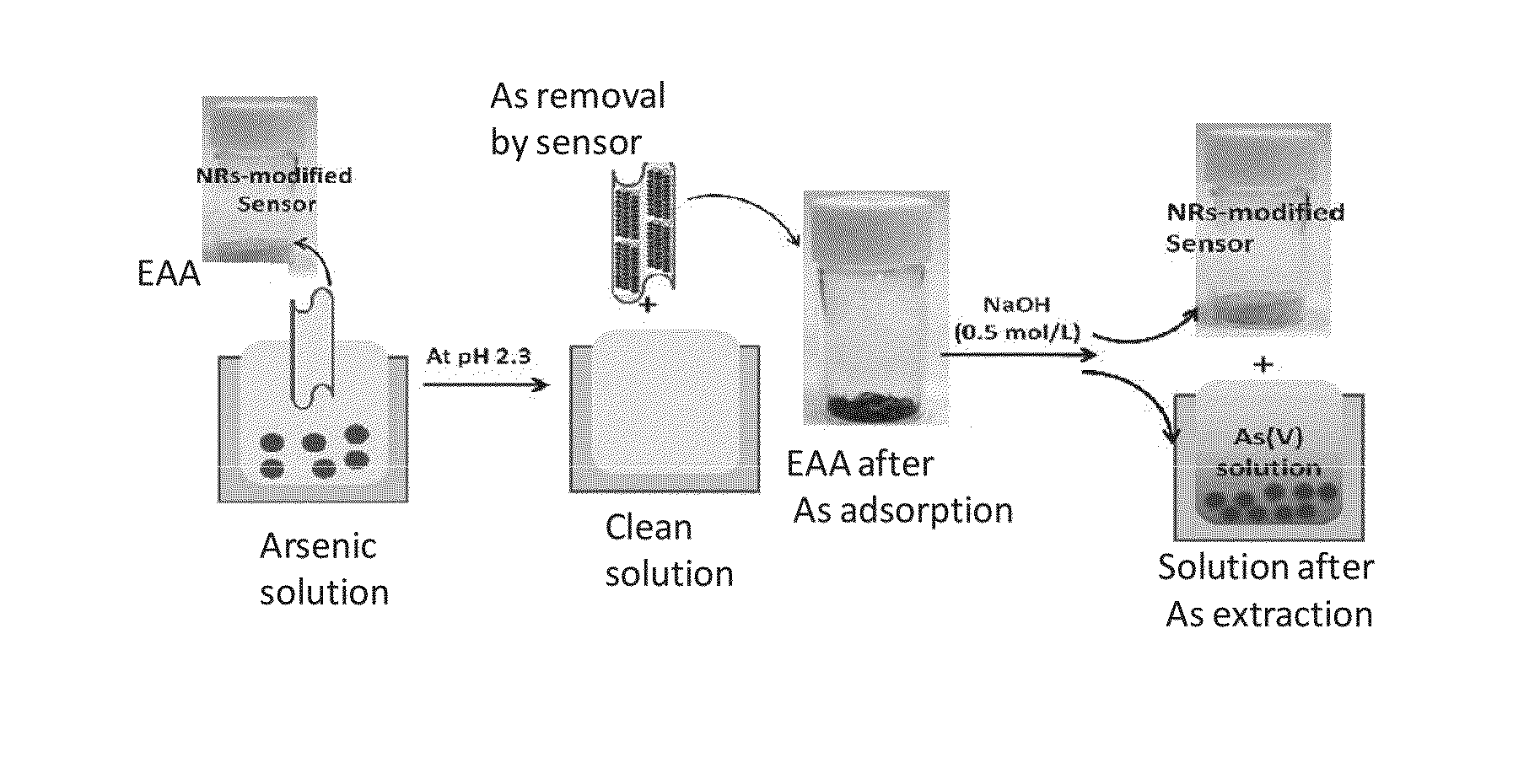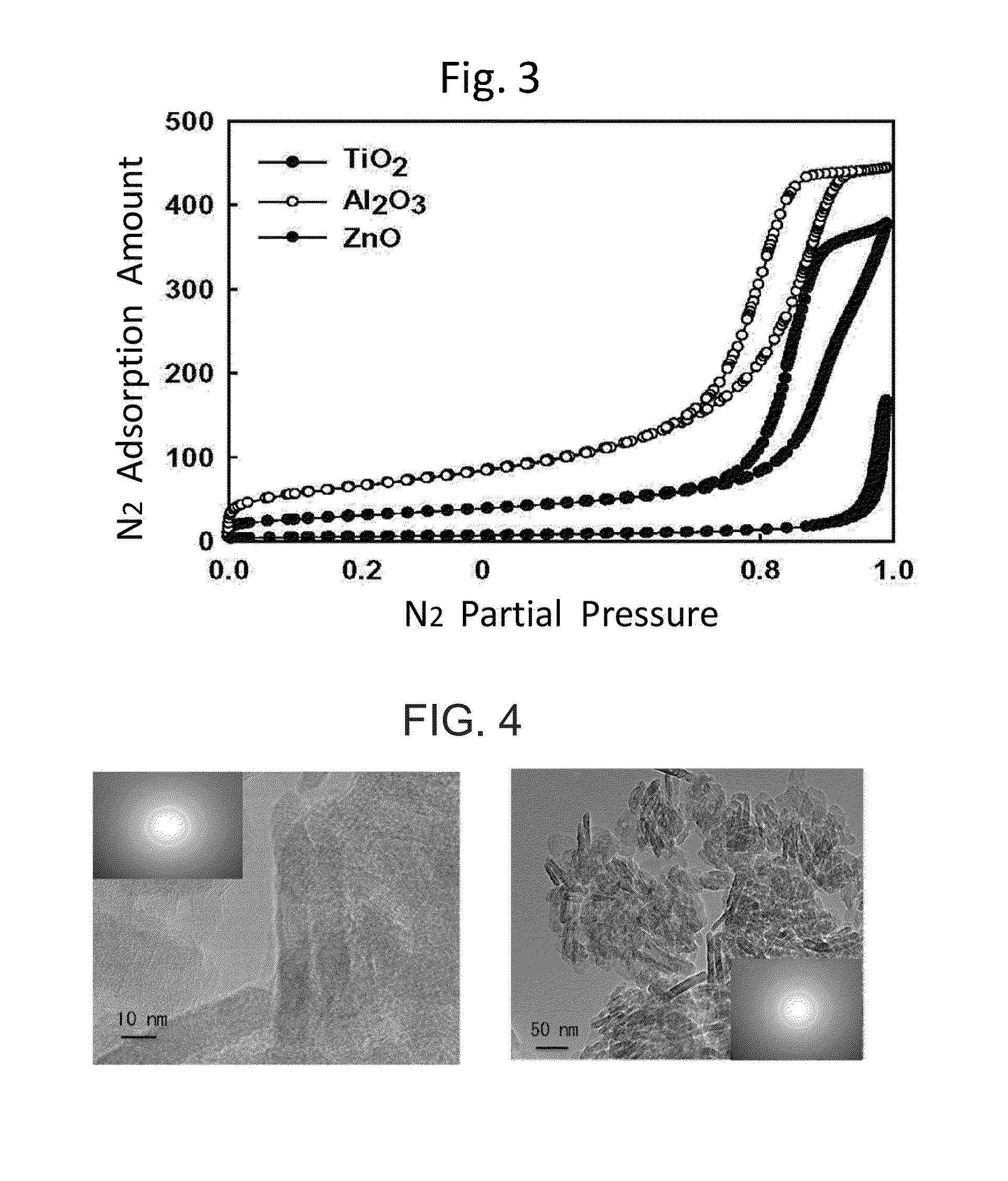Nanostructure material supporting arsenic ion adsorption compound and method to remove arsenic ion using the same
a technology of arsenic ion and nanostructure, which is applied in the field of nanostructure, can solve the problems of low productivity, inability to reduce cost, and inability to reduce arsenic concentration in the solution to ppb-ppt levels of ultra trace concentration, and achieves rapid and efficient removal of arsenic ion from the arsenic ion solution, and the effect of large porous structur
- Summary
- Abstract
- Description
- Claims
- Application Information
AI Technical Summary
Benefits of technology
Problems solved by technology
Method used
Image
Examples
example 1
Synthesis Process of Titania Nanotube
[0049]This example exemplifies a synthesis process of a titania nanotube of one of the nanostructure materials. 8 g titanyl sulfate, 10 g ethanol and 5 g H2O / H2SO4 (1 Mol) were mixed and a milky solution was obtained. Next, after 4 g F108 surfactant was added to 5 g ethanol, the ethanol was rapidly added to the milky solution. The mass ratio of TiOSO4:F108:H2O / H2SO4 was 1:0.5:0.6. After the ethanol was decompressed and removed with heating at 40° C. to 50° C. in the rotary evaporator, a gel-like solid was formed within 5 minutes. Other organic constituent was removed by calcining for 8 hours. The titania nanotube obtained has the structure shown in FIG. 1, FIG. 2 and FIG. 3. Other structural parameters are shown in Table 3. A size of the titania nanotube obtained is shown in Table 2.
[0050]
[0051]Synthesis process of an alumina nanorod structure can be easily obtained by the following procedure. 8 g precursor aluminum nitrate {Al(NO3)3} was dissolv...
example 2
[0056]This example exemplifies a method to obtain EAA by an ammonium molybdate supported by the titania nanotube prepared in the said Example 1.
(Step 1)
[0057]1 mg titania and 0.3 mg surfactant dilauryl dimethyl ammonium bromide (DDAB) {[CH3(CH2)11]2(CH3)2NBr} were mixed and stirred, and they were sucked and exhausted for 30 minutes at 35° C. by a rotary evaporator. Next, they were vacuumed and dried at 45° C. by the vacuum pump of the rotary evaporator. The solid obtained was washed, and dried at normal pressures and at 45° C.
(Step 2)
[0058]The solid obtained was mixed in the solution in which 0.3 mg (NH4)6Mo7O2424H2O was mixed in 50 ml water, and was stirred for 12 hours.
(Step 3)
[0059]The mixed solution was filtrated. The solid obtained was washed and was vacuumed and dried at 55° C. EAA supporting (NH4)6Mo7O24 on the surface of the titania is prepared. The structure shown in FIG. 4 and FIG. 5, and the structural parameters are shown in Table 4. The alumina nanorod and the zinc oxid...
example 3
[0060]This example exemplifies a detection of arsenic concentration in the solution using EAA obtained in Example 2. Twelve kinds of detective solutions shown in Table 5 were respectively mixed with a sulfuric acid aqueous solution as pH adjuster and three kinds of EAA. These mixed solutions were stirred for 25 minutes at 40° C. Next, EAA was recovered and dried after a filtration of the solution. (See FIG. 6) FIG. 8 and Table 6 show Characterization of these materials obtained by using ultraviolet, visible, and far-red spectrophotometer (SolidSpec-3700DUV made by Shimadzu corporation). Ascorbic acid was mixed to change blue color by changing hexavalent molybdenum {Mo(VI)} of As ion adsorption compound {(NH4)3[As(Mo3O10)4] complex} to pentavalent molybdenum {Mo(V)} of {(NH4)7[As(Mo3O10)4] complex}.
[0061]There is a definite correlative relationship between ppb level of As ion concentration and absorption rate (abs.) by the characterization, as is clear from Table 5 and FIG. 8. From t...
PUM
| Property | Measurement | Unit |
|---|---|---|
| pore diameter | aaaaa | aaaaa |
| pore diameter | aaaaa | aaaaa |
| pore diameter | aaaaa | aaaaa |
Abstract
Description
Claims
Application Information
 Login to View More
Login to View More - R&D
- Intellectual Property
- Life Sciences
- Materials
- Tech Scout
- Unparalleled Data Quality
- Higher Quality Content
- 60% Fewer Hallucinations
Browse by: Latest US Patents, China's latest patents, Technical Efficacy Thesaurus, Application Domain, Technology Topic, Popular Technical Reports.
© 2025 PatSnap. All rights reserved.Legal|Privacy policy|Modern Slavery Act Transparency Statement|Sitemap|About US| Contact US: help@patsnap.com



